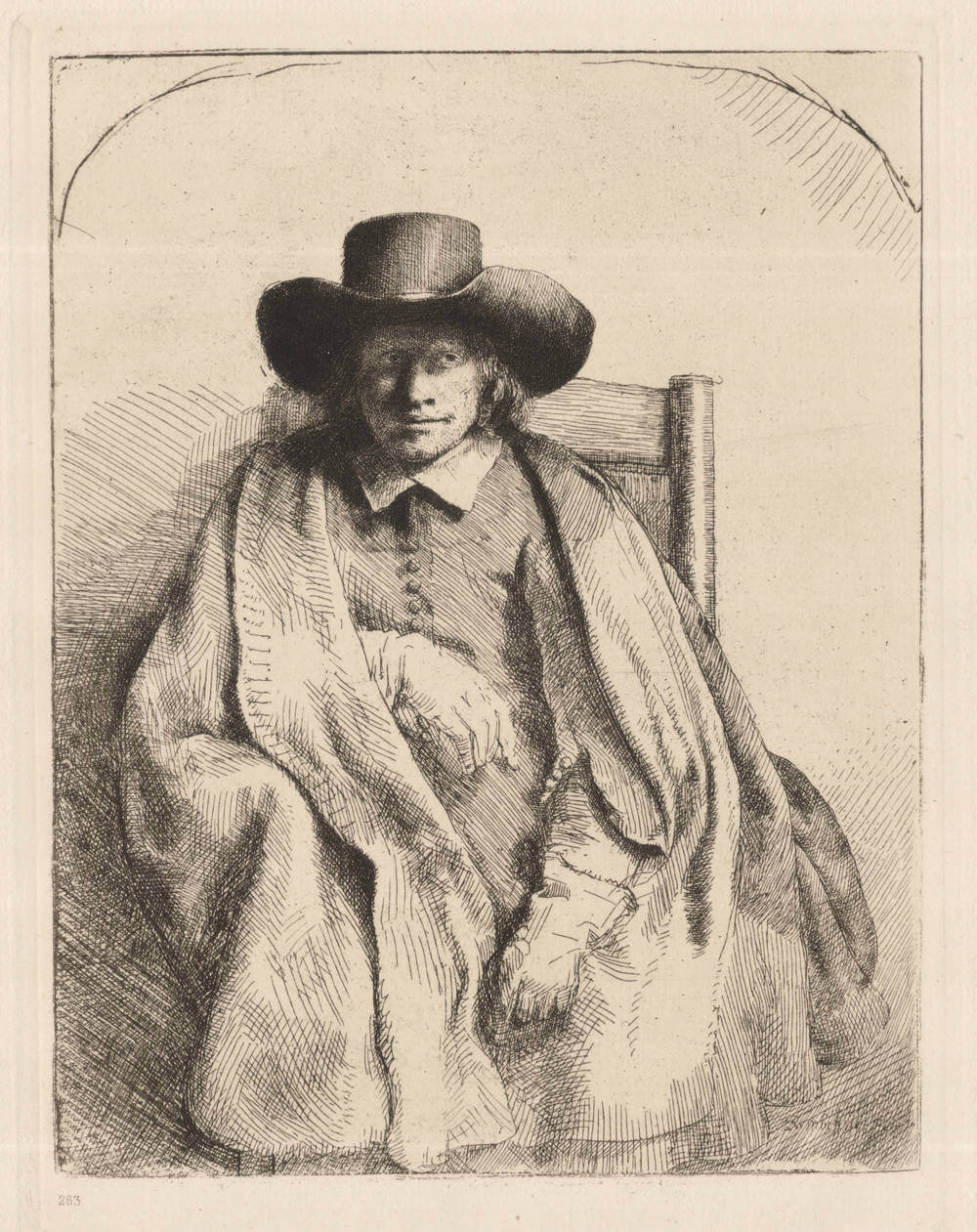Leen Helmink Antique Maps & Atlases
www.helmink.com
Rembrandt van Rijn
[no title]
Certificate of Authentication and Description
This is to certify that the item illustrated and described below is a genuine antique
map, print or book that was first produced and published in 1651, today 374 years ago.
December 16, 2025
Cartographer(s)
Rembrandt van Rijn
First Published
Amsterdam, 1651
This edition
1688
Size
20.8 x 16.2 cms
Technique
Copper etching
Stock number
19445
Condition
mint


Description
Etching and drypoint, 1651.
Clement de Jonghe (1624/25-1677) was among the largest Amsterdam print and map dealers and publishers during the mid-17th century and would certainly have been associated with Rembrandt (1606-1669), though there is no indication, through letters or in the inventory drawn up after Clement de Jonghe's death, that this was a commissioned portrait. De Jonge's business prospered from at least around 1647 to 1679, run posthumously for a couple of years following his death by his widow Jacomijntje Jacobs, until his stock was sold at auction. De Jonghe acquired at least 74 of Rembrandt's original etched copper plates, probably during Rembrandt's lifetime, and these were all sold in the contents of his estate auction. Bartsch 272; Biörklund 51-C; Hollstein (White and Boon) 272; New Hollstein 264.
Fine condition.
(Swann Galleries)
Los Angeles County Museum of Art M.67.4.
Rembrandt van Rijn (1606-1669)
Rembrandt Harmenszoon van Rijn, usually simply known as Rembrandt, was a Dutch Golden Age painter, printmaker, and draughtsman. An innovative and prolific master in three media, he is generally considered one of the greatest visual artists in the history of art.
(Wikipedia)
Clement de Jonghe (ca 1624-1677)
Clement de Jonghe was born in Brünsbuttel in the coastal region of Ditmarschen in Northern Germany. Forced by war and economic factors he moved to Amsterdam around 1643.
In 1647 he married Jacomijntje Jacobs. This marriage was very important, because it enabled him to become a formal member or “poorter” of the city of Amsterdam. This membership provided legal grounds for De Jonghe’s private enterprise as an art dealer and publisher.
A total of twelve children was born from the marriage, of which six remained alive reached maturity. Being of Lutheran faith like so many of his fellow immigrants form his former region, he went to church in the Old Lutheran Church on the Singel. Clement was eventually buried here.
De Jonghe started his business in a stand/shop near the St. Anthonisgate on the Nieuwe Waag. By 1658 he moves to a house in the Kalverstraat, which he has in rent up to 1668. He then buys the property, appropriately named “De Gekroonde Konst- en Kaart Winckel” (the crowned art and map store) and lives here the rest of his life. After his death his widow continues until 1679, when the house, store and its contents and copperplate stock is sold by auction. The house continued to be inhabited by various printers, publishers and art dealers for more than 200 years.
Being part of a new generation of printer/publisher that came into bloom around the middle of the seventeenth century, De Jonghe encountered the important and large world of printmaking and print dealing in Amsterdam. This market had been steadily growing from the late sixteenth century and was an industry with many specialised branches. Originally all participants were members of the guild of St. Luke, but by 1662 there was a schism between the print/art dealers and the booksellers.
Clement de Jonghe had a stock of 3223 copper plates. From maps to ornamental prints, art by for instance Rembrandt van Rijn and Brueghel, portraits political material and catchpenny prints. This stock represented of almost everything that was published in the seventeenth century. Plates were arranged by size and paper consumption and not directly by subject matter. The total amount of prints and books in his store amounted to 68952 items. This large stock makes it possible to have an insight into the prices of the merchandise. This must have been low, taking into consideration the vast number of prints sold in Amsterdam in the Golden Age. Just in the Kalverstraat there were at least five comparable publishers with similar stocks.
De Jonghe acquired his plates straight from artists and engravers, but in many cases also from estates of fellow print publishers. He also dealt in material produced by others. This was a normal proces; when de Jonghe’s estate was sold, several colleagues bought plates and prints in turn. A special insight into the acquisition of plates is given by the the dealings with Rembrandt who had to sell his copper plates because of financial problems.
Compared with other publishers, Clement must have been one of the major players in his day. The printing of plates was done on the first floor of the store; there is no evidence that he did book printing at home. He most probably outsourced this activity.
Trading was done both national and international; De Jonghe participated in the Frankfurter Book fair and must have known foreign dealers.
(Laurentius)